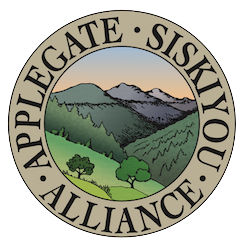 The Wellington Wildlands is an Applegate Valley gem. Located between Ruch and the Humbug Creek drainage, the area contains 7,527 acres of spectacularly intact forests, oak woodlands, chaparral, madrone groves, sweeping grasslands, beautiful wildflower displays, and incredible vistas across the Applegate Valley and the Siskiyou Mountains. The area is an important stronghold for wildlife and provides a incredible, wild backdrop for large portions of the Middle Applegate Valley.
The Wellington Wildlands is an Applegate Valley gem. Located between Ruch and the Humbug Creek drainage, the area contains 7,527 acres of spectacularly intact forests, oak woodlands, chaparral, madrone groves, sweeping grasslands, beautiful wildflower displays, and incredible vistas across the Applegate Valley and the Siskiyou Mountains. The area is an important stronghold for wildlife and provides a incredible, wild backdrop for large portions of the Middle Applegate Valley.
Over the course of the last year, Applegate Neighborhood Network, Applegate Trails Association and Applegate Valley residents, Ed Keller and Greeley Wells have collaborated to create Saving Wellington, a 22-minute film exploring the Wellington Wildlands and the need to protect this incredible area from OHV use and BLM timber sales.

We were lucky to have both Ed Keller and Greeley Wells on board to help with this unique project. Their professional cinematography and heartfelt, artistic expression of love for the Applegate Valley is evident throughout the film. We think it will give you a new appreciation for the Applegate Valley and the Wellington Wildlands.
ANN will be hosting the premiere film showing of Saving Wellington at the Red Lily Vineyard on October 13, 6:30 PM. The event will include live music from Emily Turner before the film showing. Dinner and wine from Red Lily and locally made desserts will also be available for purchase.
The event is free to the public! Please consider making a generous donation to ANN at the event and support conservation in the Applegate Valley.



Saving Wellington from logging is important for a number of reasons. The first is in regards to the impact on the community, the ecosystem, the aquifer.
Since much of the logging done is projected to impact the Eastern Side which boarders the right fork of Humbug Creek Road, it is important to note the Eastern side is considered the “dry side” and has suffered during the odd and unusual heating trends since the phenomena of a what has been called by meteorologists as a “ridiculous reoccurring ridge” of high pressure which has kept our rain fall far under historical and predicted levels. The result has impacted flora and fauna health and growth. The causes, no matter how germane, are not the issue. The reality is.
By eliminating the living “canopy” of the projected area, the sun will not be defused, shade will not exist. Ground heat will accelerate evaporation, negatively effect growth, the possibility of replanting, negatively effect the aquifer, impact wildlife that rely on micro climates and shelter. The reflective nature of the exposed hillside will impact the opposite hillside and increase die off of species already in distress. Sustainability is not treated but destroyed, desertification accelerated and forest respiration as an atmospheric adjunct to climate stabilization will cease to less than a level adequate to support boundary forest and ancillary vegetation. The encroachment area of devastation can be over one hundred meters or approximately three hundred feet.
Reforestation is a promise which has not proved itself to be as viable as touted with historical survival rates as low as 20 percent. These rates would be diminished from the desertification that most probably occur in our area with record dry spells and clear cut policies.
The dry eastern slope, especially for our area would increase fire danger, rapidity of fire travel, and danger to homes, ranches and farms as well as burdening insurance carriers. The official narrative handed down to local and state Fire Officials may not relent this if timber funds are part, if not mostly, their source revenue.
Le
The cycle of the forest is dependent of a rhythm of trees growing in relation to each other. As exampled by hardwood, such as madrone and oak, providing cover for the fledgling conifers; conifers, providing a deep forest cover and moisture for
cedars, and so on.
Older conifers and oaks provide tree protein rich lichen such as Usnea which are rich in protein the forest uses to provide a “green manure” and a source of food for deer and other creatures, who also fertilize the forest.
If cutting must be done, it should be select such as the helicopter logging we had so many years ago.
The notion supplied by an elected official to let a NGO with a notoriously bad reputation, to take over management of the forest can only be seen as either complicity or a lack of information. Neither an excuse by any means.
If greed is the generating force for logging, I suggest a moratorium of Oregon logging to drive up the price and make the gain on the “backend” in two to three years.